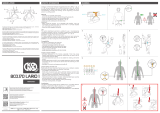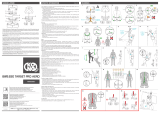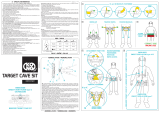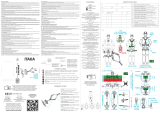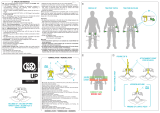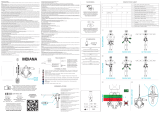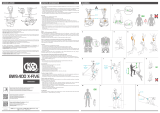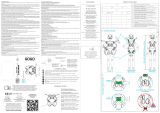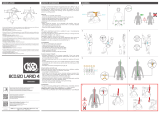La page est en cours de chargement...

EN: The Category III Personal Protective Equipment 8C9.890 ROGER (g.
1) is a sit harness equipped with a ventral attachment point (C), certied in
compliance with:
• standard EN 813:08, suitable for creating prevention and fall arrest systems
(retention, work positioning and rope access systems, etc.), and for supporting
a conscious person in a seated position,
• standards EN 12277/C and UIAA 105, suitable for creating fall protection
systems in mountaineering, including rock climbing, and for supporting a
conscious person in a seated position.
EN: (A) Waist belt, (B) Leg loops, (C) Ventral sling attachment point, (D) Back
attachment ring, (E) Adjustment slings, (F) Buckles in carbon steel, (G) nylon
or polyester Loops. Unless otherwise specied, the textile parts are made of
polyester.
IT: (A) Cintura, (B) Cosciali, (C) Punto di attacco ventrale ad un anello di
fettuccia, (D) Anello posteriore, (E) Fettucce di regolazione, (F) Fibbie in
acciaio al carbonio, (G) Passanti in nylon/poliestere. Materiale delle parti
tessili non altrimenti denito: poliestere.
FR: (A) Ceinture, (B) Tours de cuisse, (C) Point d’attache ventral à anneau
de sangle simple, (D) Anneau postérieur, (E) Sangles de réglage, (F) Boucles
en acier au carbone, (G) Passants en nylon/polyester. Matériau des parties
textiles, non autrement déni : polyester.
DE: (A) Gürtel, (B) Beinschlaufen, (C) Bauchöse an Bandschlinge, (D)
Hinterer Ring, (E) Stellbänder, (F) Schnallen aus Kohlenstoffstahl, (G)
Schlitzschnallen aus Nylon/Polyester. Material der Textilteile, wenn nicht
anders angegeben: Polyester.
S M/L XL
A (cm) 60-95 75-110 85-130
B (cm) 40-60 50-70 65-78
(g) 585 625 665
SIZE • TAGLIA
A
IT: Il Dispositivo di Protezione Individuale di III Categoria 8C9.890 ROGER (g.
1), è una imbracatura cosciale provvista di un punto di attacco ventrale (C)
certicata in accordo:
• allo standard EN 813:08, adatta alla realizzazione di sistemi di prevenzione
e di arresto cadute (anticaduta, sistemi di trattenuta, di posizionamento sul
lavoro e di accesso mediante funi, ecc.) e per sostenere in posizione seduta
una persona allo stato conscio,
• agli standards EN 12277/C:15 e UIAA 105, adatta alla realizzazione di sistemi
di protezione da cadute per l’alpinismo, inclusa l’arrampicata, e per sostenere
in posizione seduta una persona allo stato conscio.
FR: L’équipement de protection individuelle de Catégorie III 8C9.890 ROGER
(g. 1) est un harnais cuissard pourvu d’un point d’attache ventral (C), certié
selon :
• la norme européenne EN 813:08, adapté a la réalisation de systèmes de
prévention et d’arrêt des chutes (systèmes de retenue, de maintien au travail
et d’accès par corde, etc.) et pour soutenir une personne consciente en posi-
tion assise,
• la norme européenne EN 12277/C:15 et le Standard UIAA 105, adapté à la
réalisation de systèmes de protection antichute pour l’alpinisme, y compris
l’escalade, et à soutenir une personne consciente en position assise.
DE: Die persönliche Schutzausrüstung die Kategorie III 8C9.890 ROGER (Abb.
1), ist ein Hüftgurt mit einer Bauchöse (C), zertiziert nach:
• EN 813:08, geeignet für die Realisierung von Auffangsystemen (Absturz-
schutz, Arbeitsplatzpositionierungen, Aufstieg mit Seilen usw.) und für das
Stützen einer sitzenden Person in bewusstem Zustand,
• EN 12277/C:15 und UIAA 105, geeignet für die Realisierung von Absturzsi-
cherungs systemen für das Bergsteigen, einschließlich Klettern, und für das
Stützen einer sitzenden Person in bewusstem Zustand.
3
5
8 11
12 13
9 10
6 7
4
H
EN 12841
type B
EN 353-2
or
EN 12841
type A
EN 12841
type B
WL
SL
EN 353-2
or
EN 12841
type A
WL SL
EN 12841
type C
# 8C1.010
SECUR EIGHT
# 8C9.890
ROGER
# 943
GHOST
# 805.03
OTTO
# 940
CHUY
max 0,6 m
# 801
INDY
# 824
CAM CLEAN
# 824.01
FUTURA BODY
ZZV0
5564
rev.
0
ROGER
KONG s.p.a.
Via XXV Aprile, 4 - (zona industriale)
I - 23804 MONTE MARENZO (LC) - ITALY
Tel +39 0341630506 - Fax +39 0341641550 - info@kong.it
8C9.890
NOMENCLATURE • TERMINOLOGIE
NOMENCLATURE • NOMENCLATURA
Stáhněte si překlad ve vašem jazyce - Laden Sie die Übersetzung in
Ihrer Sprache herunter - Download the translation in your language
- Bájate la traducción en tu idioma - Télécharger la traduction dans
vostre langue - Scarica la traduzione nella tua lingua - Download
de vertaling in je eigen taal - Pobierz tłumaczenie w twoim języku
- Faça o download da tradução no seu idioma - Скачайте перевод
на ваш язык - 下载您语言版本的手册
2
D
A
G G
B
G G
GG
E
F F
E
C
F
E
DESCRIPTION • DESCRIZIONE
DESCRIPTION • BESCHREIBUNG
1EN 813
15 kN
EN 12277/C
15 kN

8 - SPECIFIC INFORMATION
Warning:
- the ventral attachment point (C) is not suitable for creating a fall arrest
system!
- the back attachment ring (D) is not a suitable attachment point for
making connections. Its sole purpose is as a holding point and/or
guiding point (g. 3).
- prolonged suspension on the harness, especially in motionless
conditions, may cause harness hang syndrome (or suspension
trauma) that can lead to loss of consciousness and even death!
8.1 - Harness Wearability
First of all check the size – choosing the correct one for you (see SIZE table).
How to correctly wear it:
- loosen the waist belt (A) and leg loops (B),
- slip your legs through the waist belt (A) into the leg loops (B),
- stretch the adjusting slings of the waist belt (A) and of the leg loops (B) - (g.
4),
- put the loops (G) in the correct position in order to hold the exceeding sling.
Important:
- Before using the harness, nd a completely safe position and carry out
movements and suspension tests on each attachment point to make sure
the harness is of the right size, adjusted properly and comfortable for your
intended use.
- Regularly check that the buckles are closed when in use.
8.2 - Use in Rope Access (EN 813)
Important: the maximum load applied to the harness shall be 150kg, when
used in a rope access system.
The ventral attachment point (G) on the harness is suitable for connecting to
Working Lines (WL) on an access system using a rope that allows the user
to reach and leave the work station, under tension or suspended.
Examples of devices that can be connected to the ventral attachment point
(C) to perform rope progression (g. 6).
Warning:
- check if the anchor point is conform to EN 795 norm and always
arrange it to remain above the user waistline,
- check the length of the lanyard so that it is always taught or with a
maximum slack of 0.6 meters (g. 7).
8.3 - Use in mountaineering including rock climbing (EN 12277)
The ventral attachment point (C) is suited to use for mountaineering including
rock climbing.
Tie on to the attachment point with a “gure of eight” knot, examples of
correct connection:
- with sit harness (g. 8),
- with sit harness and chest harness (g. 9)
Warning: death danger! tying on with one connector is forbidden! (g.
10).
Even if strongly unadvisable, it is possible to tie on with two self locking
connectors counter positioned as shown in g. 11.
Examples of correct connections with other devices (g. 12).
Examples of use in mountaineering including climbing (g. 13).
8.4 – Device carriage
While transporting the device adopt storage precautions (point 3) and avoid
exposition to direct sunlight and humidity.
9 - CHECKS BEFORE AND AFTER USE
Before and after use make sure that the device is in efcient condition and
working properly, particularly check:
- The textile parts do not show any signs of tears, burns, chemical residue,
excessive uff, or wear. Pay special attention to the areas that come into
contact with metal parts (buckles, rings, etc.),
- Stitching is undamaged and that there are no cut or loosen threads,
- the buckles work properly (locking, adjustment and locking) and show no
signs of cracks, corrosion and mechanical deformation and that wear is
only aesthetic.
- markings, labels included, are still readable.
8 - INFORMAZIONI SPECIFICHE
Attenzione:
- il punto di attacco ventrale (C) non è adatto per realizzare sistemi di
arresto caduta!
- l’anello posteriore (D) non è un punto di attacco adatto per effettuare
collegamenti, serve esclusivamente come punto di presa e/o di guida
(g. 3).
- la sospensione prolungata sull’imbracatura, soprattutto se inerte, può
indurre la sindrome, o trauma, da sospensione che provoca perdita di
coscienza e anche morte!
8.1 - Vestibilità dell’imbracatura
Prima di indossare l’imbracatura vericare l’idoneità della taglia (vedere
tabella TAGLIA).
Corretta vestibilità:
- allentare la cintura (A) e i cosciali (B),
- inlare le gambe nei cosciali (B) passando attraverso la cintura (A),
- tensionare le fettucce di regolazione della cintura (A) e dei cosciali (B) - (g.
4),
- posizionare i passanti (G) per trattenere le eccedenze delle fettucce.
Importante:
- prima di utilizzare l’imbracatura, in posizione di assoluta sicurezza, effettuare
movimenti e prove di sospensione per accertarsi che l’imbracatura sia
correttamente regolata e comoda per l’utilizzo previsto,
- durante l’utilizzo controllare regolarmente la chiusura delle bbie.
8.2 - Utilizzo in un sistema di accesso e posizionamento mediante funi
(EN 813)
Importante: per questo tipo di utilizzo il massimo carico applicabile
all’imbracatura è di 150 kg.
Il punto di attacco ventrale (C) dell’imbracatura è adatto per collegarsi alla
linea di lavoro (WL) di un sistema di accesso mediante corda che permette
all’utilizzatore di raggiungere e lasciare il luogo di lavoro, in tensione o in
sospensione (g. 5).
Esempi di dispositivi collegabili al punto di attacco ventrale (C) per effettuare
la progressione su corda (g. 6).
Attenzione:
- vericare che il punto di ancoraggio sia conforme alla norma EN 795 e
che rimanga sempre al di sopra della vita dell’utilizzatore,
- vericare che la lanyard di collegamento rimanga sempre tesa o con un
lasco massimo di 0,6 metri (g. 7).
8.3 - Utilizzo in alpinismo inclusa l’arrampicata (EN 12277)
Il punti di attacco ventrale (C) è adatto all’utilizzo in alpinismo inclusa
l’arrampicata.
Legarsi al punto di attacco con nodo a otto, esempi di corretta legatura:
- con imbracatura cosciale (g. 8),
- con imbracatura cosciale e pettorale (g. 9).
Attenzione: pericolo di morte! È assolutamente vietato legarsi utilizzando
un solo connettore! (g. 10).
Anche se altamente sconsigliato, è possibile legarsi utilizzando due connettori
con ghiera posizionati contrapposti (g. 11).
Esempi di corretto collegamento con altri dispositivi (g. 12).
Esempi di utilizzo in alpinismo inclusa l’arrampicata (g. 13).
8.4 - Trasporto del dispositivo
Durante il trasporto del dispositivo adottare le precauzioni per
l’immagazzinamento (punto 3) ed evitare l’esposizione diretta alla luce del
sole e l’umidità.
9 - CONTROLLI PRE E POST USO
Prima e dopo l’uso assicurarsi che il dispositivo sia in condizioni efcienti e
funzioni correttamente, in particolare controllare che:
- le parti tessili non presentino tagli, bruciature, residui di prodotti chimici,
eccessiva peluria, usura, in particolare vericate le zone in contatto con
componenti metallici (bbie, anelli, ecc.),
- le cuciture siano integre e che non vi siano li tagliati o allentati,
- le bbie funzionino correttamente (bloccaggio, regolazione e bloccaggio),
che non abbiano cricche, tracce di corrosione, deformazioni meccaniche e
che l’eventuale usura sia esclusivamente di carattere estetico,
- le marcature, comprese le etichette, siano leggibili.
8 – INFORMATIONS PARTICULIÈRES
Attention :
- le point d’attache ventral (C) ne convient pas aux actions des systèmes
d’arrêts des chutes !
- Attention : l’anneau postérieur (H) n’est pas un point d’attache conve-
nant à effectuer des connexions, il sert exclusivement comme point de
prise et/ou de guidage (g. 3).
- la suspension prolongée dans le harnais, surtout lorsque le corps
est inerte, peut provoquer le syndrome (ou trauma) de suspension qui
cause une perte de conscience et même la mort !
8.1 - Simplicité de port du harnais
Avant de mettre le harnais, vérier que la taille soit idoine (voir le tableau
TAILLE).
Simplicité de port :
- desserrer la ceinture (A) et les cuissards (B),
- enler les jambes dans les tours de cuisse (B) en passant à travers la cein-
ture (A),
- mettre en tension les sangles de réglage de la ceinture (A) et des tours de
cuisse (B) – (g. 4),
- placer les passants (G) de sorte à retenir les parties de sangle restantes.
Important :
- avant d’utiliser le harnais, en position de sécurité absolue, exécuter des
mouvements et des essais de suspension pour s’assurer que le harnais soit
réglé correctement et qu’il soit confortable pour l’emploi prévu,
- pendant l’emploi, vérier régulièrement la fermeture des boucles.
8.2 - Emploi dans un système d’accès et de maintien par corde (EN 813)
Important : pour ce type d’emploi, la charge maximale applicable au harnais
est de 150 kg.
Le point d’attache ventral (C) du harnais est indiqué pour s’attacher à la ligne
de travail (WL) d’un système d’accès par corde qui permet à l’utilisateur d’at-
teindre et de quitter le lieu de travail, en tension ou en suspension (g. 5).
Exemples d’équipements pouvant être reliés au point d’attache ventral (C)
pour effectuer la progression sur corde (g. 6).
Attention :
- vérier que le point d’ancrage soit conforme à la norme européenne EN
795 et qu’il reste toujours au-dessus de la taille de l’utilisateur,
- vérier que la longe de connexion soit toujours tendue ou que le lâche
maximal ne dépasse pas 0,6 mètres (g. 7).
8.3 - Emploi en alpinisme, escalade comprise (EN 12277)
Le point d’attache ventral (C) convient à être employé en alpinisme, escalade
comprise.
Se lier au point d’attache avec un nœud en huit. Exemples de liage correct :
- avec harnais cuissard (g. 8),
- avec harnais cuissard et torse (g. 9).
Attention : danger de mort : Il est absolument interdit de se lier en util-
isant un seul connecteur ! (g. 10).
Bien que cela soit hautement déconseillé, il est possible de s’attacher à l’aide
de deux connecteurs avec virole à vis placés à l’opposé l’un de l’autre (g.
11).
Exemples de connexion correcte avec d’autres dispositifs (g. 12).
Exemples d’emploi en alpinisme, escalade comprise (g. 9 et 13).
8.4 – Transport de l’équipement
Lors du transport de l’équipement, tenir compte des précautions prévues pour
l’entreposage (point 3) et limiter l’exposition directe à la lumière du soleil et
à l’humidité.
9 - CONTRÔLES AVANT ET APRÈS L’EMPLOI
Avant et après l’emploi, s’assurer que l’équipement soit dans des conditions
efcaces et qu’il fonctionne correctement ; s’assurer notamment que :
- les parties textiles n’aient aucun signe de coupure, brûlure, résidus de pro-
duits chimiques, un duvet excessif, de l’usure, vériez particulièrement les
zones en contact avec les composants en métal (boucles, anneaux, etc.),
- les coutures soient intactes et qu’il n’y ait pas de ls coupés ou lâches,
- les boucles fonctionnent correctement (blocage, réglage et blocage), qu’elles
ne présentent aucun signe de ssures, traces de corrosion, déformations mé-
caniques et que l’usure éventuelle soit exclusivement à caractère esthétique,
- les marquages, y compris les étiquettes, soient lisibles.
8 – SPEZIFISCHE INFORMATIONEN
Achtung:
- Die Bauchöse (C) ist nicht für die Realisierung von Auffangsystemen
geeignet!
- Der hintere Ring (D) ist nicht der geeignete Anschlagpunkt für Verbin-
dungen, sondern dient als Griff bzw. Führung (Abb. 3).
- Längeres Hängen im Klettergurt, vor allem wenn man sich nicht be-
wegt, kann zum Hängesyndrom (oder Hängetrauma) führen, das Be-
wusstlosigkeit und auch Tod verursachen kann!
8.1 – Tragbarkeit des Auffanggurts
Vor dem Anziehen des Auffanggurts die richtige Größe prüfen (siehe Tabelle
GRÖSSE).
Richtiges Anziehen:
- Den Gürtel (A) und die Beinschlaufen (B) lockern,
- die Beine in die Beinschlaufen (B) stecken und dabei den Gürtel (A) an-
ziehen,
- die Stellbänder des Gürtels (A) und der Beinschlaufen (B) festziehen - (Abb.
4),
- die Schlitzschnallen (G) positionieren, um überschüssiges Band zu befes-
tigen.
Wichtig:
- Vor dem Gebrauch des Klettergurts in absolut sicherer Position Bewegun-
gen und Tests für das Hängen ausführen um sicherzustellen, dass der Klet-
tergurt richtig eingestellt und für den vorgesehenen Gebrauch bequem ist,
- Während des Gebrauchs regelmäßig den Verschluss der Schnallen prüfen.
8.2 – Verwendung in einem Steig- und Positionierungssystem mit Sei-
len (EN 813)
Wichtig: Für diese Anwendung beträgt die maximale Belastbarkeit des Klet-
tergurts 150 kg.
Die Bauchöse (C) des Klettergurts eignet sich zur Befestigung an das Steig-
seil (WL) eines Steigsystems mit einem Seil, das es dem Anwender gestat-
tet, den Arbeitsplatz zu erreichen oder zu verlassen, sitzend oder hängend
(Abb. 5).
Beispiele der an die Bauchöse (C) anschließbaren Vorrichtungen für den
Seilaufstieg (Abb. 6).
Achtung:
- Prüfen, dass der Anschlagpunkt der EN 795 entspricht und sich immer
oberhalb der Hüfte des Anwenders bendet,
- Prüfen, dass das Verbindungsmittel (Lanyard) immer gespannt ist
oder maximal 0,6 m durchhängt (Abb. 7).
8.3 – Gebrauch beim Bergsport einschließlich Bergsteigen (EN 12277)
Die Bauchöse (C) eignet sich für den Einsatz beim Bergsport einschließlich
Bergsteigen.
Sich mit einem Achterknoten an der Bauchöse befestigen. Beispiele für rich-
tiges Anschlagen:
- mit Hüftgurt (Abb. 8),
- mit Hüftgurt und Brustgurt (Abb. 9),
Achtung, Lebensgefahr! Es ist strengstens verboten, sich mit nur ei-
nem Karabiner einzuhängen! (Abb. 10).
Auch wenn davon abgeraten wird, kann man sich mit zwei Karabinern mit
Schraubverschluss einhängen, die einander gegenüber liegen (Abb. 11).
Beispiele für richtige Verbindung mit anderen Vorrichtungen (Abb. 12).
Anwendungsbeispiele beim Bergsport einschließlich Bergsteigen (Abb. 13).
8.4 – Transport der Ausrüstung
Beim Transport der Ausrüstung die für die Lagerung genannten Vor-
sichtsmaßnahmen (Punkt 3) berücksichtigen und die direkte Sonnenbestrah-
lung und Feuchtigkeitseinwirkung begrenzen.
9 – KONTROLLEN VOR UND NACH DEM GEBRAUCH
Vor und nach dem Gebrauch sicherstellen, dass die Ausrüstung einsatzfähig
und betriebstüchtig ist. Insbesondere kontrollieren, dass:
- die textilen Teile keine Schnitte, Verbrennungen, Reste von Chemikalien, zu
starke Fusselbildung, Verschleiß aufweisen und insbesondere die Bereiche
in Kontakt mit Metallkomponenten prüfen (Schnallen, Ringe usw.),
- die Nähte unversehrt sind und keine geschnittene oder lockere Fäden auf-
weisen,
- die Schnallen richtig funktionieren (Klemmung, Regulierung und Klem-
mung), keine Risse, Korrosionsspuren, mechanische Verformungen auf-
weisen und dass ggf. vorliegender Verschleiß ausschließlich ästhetischen
Charakters ist.
- die Markierungen einschließlich der Etiketten lesbar sind.
EN
Master text: ITALIAN Teste de référence: ITALIENNE Referenztext: ITALIENISCH
IT FR DE
NB n° 2008
DOLOMITICERT scarl
Zona Industriale Villanova
30013 Longarone BL - Italy
Download the declarance of conformity at:
Scarica la dichiarazione di conformità a :
Télécharger la déclaration de conformité à:
Laden Sie die Konformitätserlärung herunter zu:
www.kong.it/conformity
Conformity to European Norm
Conformità alla Norma Europea
Conforme à la norme européenne
Entspricht der Europäischen Norm
EN 813:2008
EN 12277/C:2015
Ventral attachment points
Punti di attacco ventrale
Points d’attache ventral
Ventrale Befestigungspunkte
Adjustment and locking of the webbing
Regolazione e bloccaggio delle fettucce
Réglage et blocage des anneaux de sangle
Regulieren und Klemmen der Bänder
Maximum user weight, equipment included
Peso massimo dell’utilizzatore, compreso
di equipaggiamento
Poids maximal de l’utilisateur, équipement compris
Maximales Benutzergewicht, einschließlich
Ausrüstung
MAX 150 kg
CERTIFIED BY • CERTIFICATO DA
CERTIFIÉ PAR • ZERTIFIZIERT VON
MARKING • MARCATURA
MARKIERUNG • MARQUAGE
1/2

